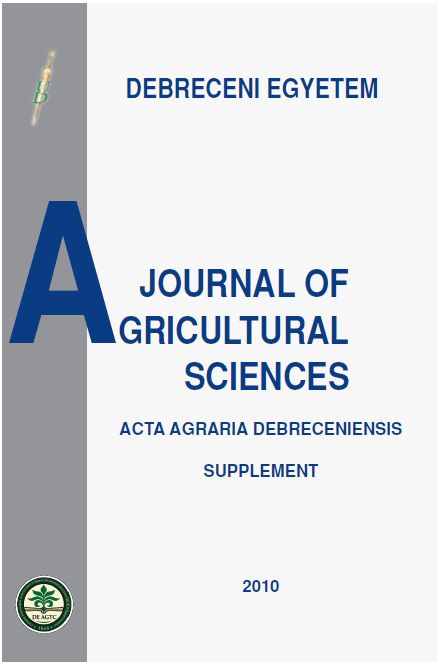The effects of agrotechnological factors on winter wheat yield in humid cropyear
Authors
View
Keywords
License

This work is licensed under a Creative Commons Attribution 4.0 International License.
How To Cite
Abstract
The effects of crop rotation, nutrien supply and crop protection technologies, as well as the appearance of the main ear- and leafdiseases
(powdery mildew, helminthosporium leaf spot, leaf rust, fusarium) were studied on the crop yields of winter wheat variety MV
Pálma during the 2009/2010 crop year. The experiments were conducted in triculture (pea – wheat – corn) and biculture (wheat – corn), at
five nutrition levels, with the use of three crop protection technologies (extensive, conventional and intensive) at the Látókép Research Site of
the University of Debrecen, Centre of Agricultural Sciences. Our results proved that the appearance of leaf- and ear-diseases were
significant in the wheat cultures during the 2009/2010 crop year, because of the rainy, warmer than usual weather, the lodging, and the huge
vegetative mass developed. The most severe infections by the four examined diseases after pea and corn pre-crops were observed at
extensive crop protection levels, when fertilizers were used at the highest dose.
Following corn pre-crop, in the case of all the three crop protection technologies the maximum rate of wheat yield results were achieved
at N150+PK level. The highest yield was reached at intensive crop protection level (6079 kg ha-1). In triculture, in case of all the three crop
protection technologies the maximum yields were achieved at N50+PK level; in extensive technology 5041 kg·ha-1 yield, in conventional
technology 6190 kg ha-1 yield was realised, while in the intensive technological model the yield was 7228 kg ha-1.
The relationship between yield and fertilizer amounts, the rate of pathogen contaminations, crop protection technologies and pre-crops
was defined with correlation analysis in case of different crop rotations during the 2009/2010 crop year. Based on the results of the
experiment, we found that in stands after corn pre-crop strong positive correlation was established between the crop protection level and the
crop yield (0.543), the nutrient levels and the emergence of the four examined pathogens, and between the nutrient levels and the yield
(0.639). Extremly strong positive correlation was observed between crop protection and yield (0.843) in triculture. Strong positive
correlation was detected between the nutrient levels and the presence of the four examined pathogens, as well as between nutrient and
lodging (0.688). Strong negative correlation was between the crop protection level and the four examined diseases both in biculture and
triculture.

 https://doi.org/10.34101/ACTAAGRAR/I/8396
https://doi.org/10.34101/ACTAAGRAR/I/8396